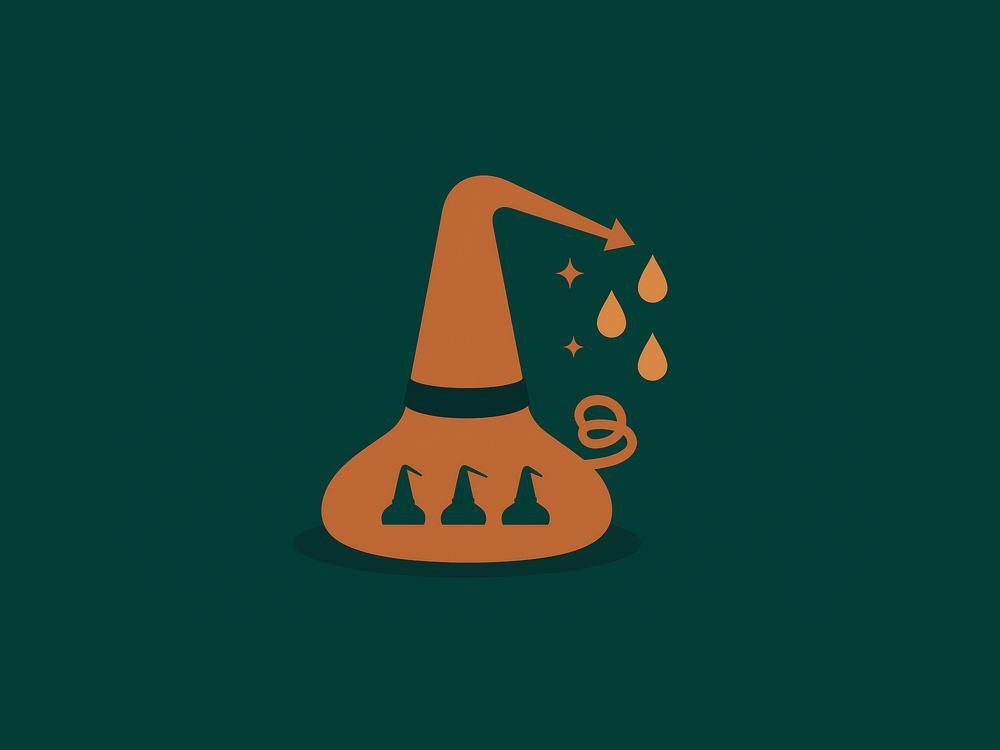TLDR
Mortlach’s ‘2.81 times’: the Wee Witchie and an old-school Speyside distillation
Mortlach runs an unusual regime with six pot stills and worm-tub condensing. Part of the flow is triple-distilled in a small spirit still nicknamed the “Wee Witchie,” then blended with two other streams. The weighted average of those paths is often described as “2.81 times” distilled - a shorthand for a configuration that produces dense, meaty spirit.The Long Read
Published August 15, 2025

New to the production steps? Start with Whisky production and the basics of Pot stills. For how condensers change texture, see Condensors. Curious how this differs from plate columns? Compare with Continuous distillation.
The headline: what does “2.81 times” distillation mean?
At Mortlach the spirit isn’t simply double distilled in a neat wash-then-spirit sequence. Instead, the stillhouse splits the output of the wash stills into multiple streams, redistills them on different spirit stills, and then recombines them.
- Stream A runs conventionally (wash → spirit) and becomes one part of the final vatting.
- Stream B is redistilled once on another spirit still and joined to the mix.
- Stream C - the crucial wrinkle - is a weaker fraction that goes to a small spirit still nicknamed the Wee Witchie, where it is distilled three times before its middle cut is taken and married back with the other streams.
Because one portion is distilled twice, another portion twice, and a smaller portion three times, the weighted average across the whole spirit charge works out to the oft-quoted “2.81 times.” It’s not a literal pass-counter so much as an arithmetic summary of a quirky flow plan.
Meet the Wee Witchie
The Wee Witchie is Mortlach’s diminutive spirit still. Its role is to concentrate and polish a deliberately weak, feinty slice from the wash run. Distilling this fraction three times tightens the cut window and drives extra copper interaction, before the cleanest heart is added back to the main spirit vat.
Key enablers:
- Cut management at the spirit safe - the stillmen decide what becomes heads/foreshots, heart, and tails/feints and where those streams are recycled. See the primer on the Spirit safe.
- Worm-tub condensation - Mortlach condenses vapor in traditional coils submerged in cold water (a type covered under Condensors). Worm tubs tend to reduce copper contact during condensation, helping retain weight, sulphury/meaty bass notes, and an oily mouthfeel.
Together, the Witchie’s triple pass plus worm-tub character help create the style fans dub the “Beast of Dufftown.”
Why build a system like this?
Mortlach’s layout is a house-style machine:
- Texture first: Instead of chasing maximal purity, the regime prizes a dense, stock-like spirit that can stand up to long maturation (notably in European oak).
- Selective polishing: By triple-distilling only a targeted weak cut (rather than the entire low wine), Mortlach can clean up specific congeners without thinning the whole make.
- Stills as ingredients: Different shapes, sizes and lyne-arm geometries behave like separate tools (see Types of whisky stills). Blending their outputs before cask is akin to a pre-maturation “recipe.”
How it contrasts with triple distillation elsewhere
In a classic triple-distilled setup (think parts of Ireland, or Scotland’s Auchentoshan), all spirit effectively undergoes three passes, often yielding a higher take-off strength and a lighter, fruit-forward profile. Mortlach’s approach is different: only a portion is triple-distilled, and worm-tub condensation re-adds heft.
For an even more extreme counter-example, Bruichladdich experimented with X4 (quadruple distillation) to push purity to an eye-watering degree - a reminder that more redistillations ≠ universally ‘better’, just different aims.
What ends up in the glass?
Expect:
- Aromatics: roasted malt, cooked meats/umami, dark fruit; occasional struck-match notes that time and oak integration transform.
- Palate/texture: viscous and weighty, a signature of worm-tub condensation and intentional retention of heavier congeners.
- Maturation: thrives in sherry-led casks where structure and sweetness meet the spirit’s savory core.
FAQs
Is 2.81 an exact count of distillations?
No. It’s a shorthand for a weighted average across streams distilled two and three times.
Couldn’t Mortlach just triple-distil everything?
It could, but the point is selectivity. Triple-distilling only the weak fraction via the Wee Witchie lets Mortlach polish without losing the muscle it’s famous for.
Is this the same as running a column still?
No. Mortlach uses batch copper pots (see Pot stills), not plates and continuous reflux as outlined under Continuous distillation.
See also
- Distillery page: Mortlach
- Context on stills and hardware: Pot stills • Condensors • Spirit safe • Types of whisky stills
- Comparators: Auchentoshan (routine triple distillation) • Bruichladdich (X4 experiment)
Key takeaways
- “2.81 times” is an average, not a literal pass counter.
- The Wee Witchie triple-distils a targeted weak stream, then that heart rejoins two other streams.
- Worm-tub condensation and selective triple-distillation create Mortlach’s meaty, weighty house style built for long, sherry-friendly maturation.

